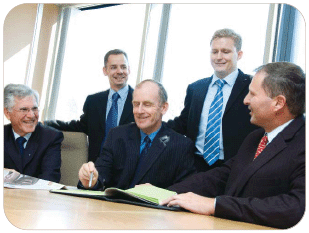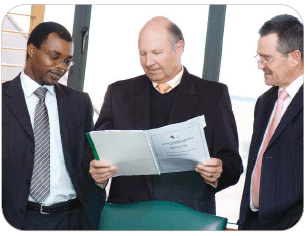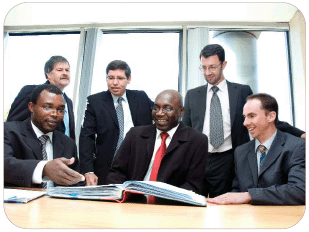Review of operations |
|||||||||||||||||||||||||||||||||||||||||
Iron ore sales reached a record level of 7,4 million tons, due mainly to the ongoing demand for iron ore from China. |
 |
||||||||||||||||||||||||||||||||||||||||
MANGANESE ORE AND ALLOYSManganese ore is mined by Assmang in the Black Rock area of the Northern Cape province and manganese alloys are produced at the Cato Ridge Works in KwaZulu-Natal (the Works). Cato Ridge Alloys, a joint venture between Assmang, Mizushima Ferroalloys Company Limited and Sumitomo Corporation Limited (both of Japan), produces refined ferromanganese by introducing oxygen through a lance into a converter which contains molten metal supplied by the Works, reducing the carbon content of the alloy. Feed for the Works is derived from Assmang’s manganese mines and the bulk of both ore and alloy production is exported. Sales tonnages of manganese ore and alloy for the year were as follows:
Manganese ores and alloys are used in the production of crude steel. Demand for both ore and alloy virtually disappeared as a result of the world economic turmoil which set in during October 2008, following which our customers reduced their production levels as demand evaporated.This was followed by a period of destocking when apparent demand was even lower than actual demand and our customers tried to reduce their stocks of high cost raw materials. Manganese ore demand started to pick up first in the last quarter of the financial year with substantial exports into China and the rest of Asia. Purchasers in the rest of the world are now also indicating the need to replenish stocks. During this period, ore prices plunged to less than 25% of the record levels which exceeded US$16 CIF per manganese unit reached in mid 2008, to lows of US$3,50 CIF per manganese unit.There are recent signs of a price recovery as some high cost marginal producers have exited the market. Manganese alloys were also severely affected and both volumes and prices fell dramatically. By the last quarter of the year, the high-carbon ferromanganese prices were down from a peak of US$3 000 per ton to below US$1 000 per ton. Likewise, medium-carbon ferromanganese prices fell to below US$1 600 per ton from over US$4 000 per ton since July 2008. Fortunately, response from the alloy industry was fast and decisive as producers closed or cut production with the result that towards the end of the final quarter we saw increased demand and some limited price recovery. Production and sales volumes for the year were both reduced markedly. The outlook for sales of manganese alloys in the coming year is dependent on both recovery of steel production outside China and continued production restraint from major western alloy producers. Sales of high-carbon ferromanganese were significantly lower at 79 000 tons for the year (2008: 174 000 tons), whilst inventories are being managed to levels appropriate to expected sales. The lower prices for fiscal 2009, combined with the lower sales volumes, resulted in the contribution to the headline earnings of Assore from this division decreasing to R1 963 million (2008: R2 044 million). Capex for the year for the manganese division was R854 million (2008: R511 million) of which R161 million was spent on the new ore treatment plant at Nchwaning Manganese Mine. CHROME AND CHROME ALLOYSChrome ore is mined at Assmang’s Dwarsrivier Mine near Lydenburg in Mpumalanga province and production is used mainly to supply Assmang’s Ferrochrome Works at Machadodorp. The group also mines chrome ore near Rustenburg (Rustenburg Minerals Development Company (Proprietary) Limited) (RMDC) mainly in open-cast operations and production is supplied mainly to the local market (refer to black economic empowerment). The bulk of chrome ore mined worldwide is converted to ferrochrome and utilised in the production of stainless steel. Like manganese, the chrome division was significantly affected by the economic turmoil. Stainless steel production for the first fiscal half was down over 26% at 11,45 million tons, and deteriorated further in the second half. Global production for calendar 2009 is unlikely to exceed 24 million tons (2008: 26,5 million tons).This is higher than previously expected due to strong Chinese production and demand which also benefited other producers, particularly in Asia. However, production in Asia appears to be moderating. This significant reduction in stainless production had a catastrophic effect on the ferrochrome market, with virtually no demand by the end of calendar 2008 and early 2009, and prices falling by well over 60%.As a result, ferrochrome production, particularly in South Africa, was slashed in order to balance the market.The earlier than expected upturn in the stainless market, particularly in China coincided with the higher South African winter electricity tariff, with a significant number of furnaces being switched out for maintenance during this period.Therefore, the ferrochrome market tightened due to the resultant lower inventory levels. There are, however, concerns that the rapid ramp-up of production after the winter period will coincide with Chinese stainless production being moderated to reflect real consumption. Assmang’s charge chrome sales decreased by 62,5% to 103 000 tons for the financial year (2008: 275 000 tons), while chrome ore sales dropped by 15,8% to 256 000 tons (2008: 304 000 tons) as surplus chrome ore was sold in order to minimise the effect of the market downturn on the division. Approximately 338 000 tons (2008: 342 000 tons) of run of mine, lumpy and concentrate were produced by RMDC during the year which, as a result of higher prices, resulted in a net profit after tax of R84 million (2008: R54 million) of which R37 million (2008: R24 million) was attributable to minorities, being BEE partners, Mampa Investment Holdings (Proprietary) Limited. Mining operations at RMDC are still open-cast, however, these resources will be largely depleted within the next 18 months and two underground shafts are being developed on the existing deposits at an estimated cost of R158 million. Development of these shafts commenced in the 2008 fiscal year, with R48 million being spent in the year (2008: R50 million).The remainder of the capital expenditure required on the new shafts will be funded from the cash resources of RMDC and, if required, loan facilities made available by Assore. IRON OREIron ore is mined in the Northern Cape by Assmang in open-cast operations at the Khumani Iron Ore Mine near Kathu (Khumani) and at the Beeshoek Mine, which is located outside Postmasburg. Khumani has the installed capacity of approximately 10 million tons of saleable iron ore per annum. Iron ore sales reached a record level of 7,4 million tons (2008: 6,6 million tons), due mainly to the ongoing demand for iron ore from China. Spot prices for iron ore in China fell dramatically after the world economic turmoil, which resulted in the mothballing of high cost domestic capacity. Ironically, this pushed up demand for imported ore. Production from the new Khumani mine ramped up as planned and was available to meet this demand. Pricing in the iron ore market is in a state of transition.The traditional annual benchmark pricing system is under threat, particularly in China. Settlements over the last two years have included sales at spot. Major iron ore producers are split on their views as to whether an indexing pricing method should replace the benchmark. Having said that, provisional prices were agreed on for the last quarter of the year under review at 45% and 33% down for lump and fines respectively and although negotiations are still ongoing, we expect that, especially in China, these levels will prevail in the new financial year. Sales volume for the new financial year is expected to reach 9,8 million tons with all export volumes coming from Khumani and local sales being sourced from Beeshoek.
Wear-resistant tiles and other engineered products (eg pump plungers, laboratory crucibles) are produced by the company’s technical ceramics division, Ceramox.Turnover has increased by 13,6% in the past year following the completion of the first phase of the capital expansion project scheduled for completion by the end of calendar 2009. In addition,Wonderstone is produced in powder form to customer-specific, particle size distribution requirements.This specified powder can be supplied in natural, calcined or spray dried form. Customers for these products benefit from the higher degree of technical support with regard to the product’s performance characteristics and technical applications. Both the mine and its manufacturing operations have been awarded ISO 9001: 2000 and ISO 14001 accreditation. Turnover for the year remained constant at R40 million (2008: R40 million) with increased sales prices being negated by the lower sales volumes. Favourable exchange rates resulted in an increased profit for the year of R7 million (2008: R5 million). Capital expenditure for the year amounted to R14 million (2008: R16 million), most of which was spent on the expansion of plant for the manufacturing operations. SYNTHETIC DIAMONDSThe group’s synthetic diamond production facility operates from premises in Linbro Park on the outskirts of Johannesburg under the name of Xertech.Two additional 14 000 ton presses were commissioned during the year, which places the facility in a position to maintain stock levels in line with anticipated sales volumes.The quality of the product is pleasing, and the presses have been commissioned to operate successfully at specified capacity. However, global trading conditions, and excessive supply in the market of inferior products have resulted in Xertech incurring a trading loss of R30 million (2008: R27 million loss) for the year, increasing to a net loss of R89 million by an impairment charge of R59 million against its assets. Production has been curtailed to take into account the current lower level of demand, and will be increased based on customer demand which is expected to increase in line with world economic recovery. Capital expenditure for the year was R5 million (2008: R14 million) and related mainly to ancillary equipment required for the new presses.
MINERAIS U.S. LLCThe group holds a 51% share in Minerais U.S. LLC (Minerais) which is a limited liability company registered in the state of New Jersey in the United States of America (USA). Minerais is responsible for marketing and sales administration of the group’s products in the USA, in particular manganese and chrome alloys, and trades in various commodities related to the steel-making industry.The contribution by the company to the group’s net profit decreased to R13 million (2008: R50 million), due to the significant impact of the economic turmoil, more prevalent in the USA. TECHNICAL AND OPERATIONAL MANAGEMENTAs technical adviser to Assmang and other group companies, African Mining and Trust Company Limited provides operational management services to the group’s mines and plants. For these services it receives fee income based on turnover and commodity prices, with trading net profit after taxation for the year increasing to R174 million (2008: R114 million). INVESTMENTSThe group maintains a portfolio of listed shares which are selected and held in accordance with long-term investment criteria. Additions were made to the portfolio during the year at a cost of R118 million (2008: R149 million) and disposals generated a profit after capital gains tax of R16 million (2008: R19 million).The portfolio is valued in the financial statements at market value and the difference between cost and market value is transferred to other reserves net of any capital gains tax which would arise on eventual disposal. At year-end the market value of the remaining portfolio was R415 million (2008: R590 million) based on a cost of R296 million (2008: R181 million). Dividends received on the portfolio for the year were R20 million (2008: R9 million). Other income includes interest received of R367 million (2008: R68 million) generated from cash in excess of current requirements which was invested on a short-term basis in the money market. |
|||||||||||||||||||||||||||||||||||||||||


